Progress MS-06 to resupply ISS (original) (raw)
Progress MS-06 arrives at ISS
The second Russian cargo mission bound this year to the International Space Station, ISS, lifted off as scheduled from Baikonur Cosmodrome on June 14. In the ISS flight manifest, the Progress MS-06 spacecraft has the designation 67P denoting the 67th Russian supply vehicle heading to the outpost, while in production documentation it was designated No. 436. Two days after launch, Progress MS-06 should deliver around 2.5 tons of supplies to the ISS, along with a cluster of small satellites to be released in orbit.
Previous mission: Progress MS-04
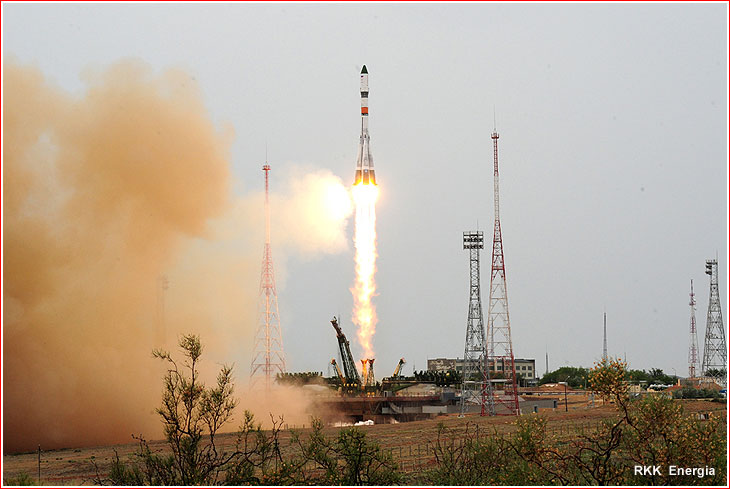
The Soyuz-2-1a rocket with the Progress MS-06 spacecraft lifts off on June 14, 2017.
From the publisher: Pace of our development depends primarily on the level of support from our readers!
Progress MS-06 mission at a glance:
| Spacecraft designations | Progress MS-06 (Production designation: 11F615 No. 436) |
|---|---|
| Launch vehicle | Soyuz-2-1a No. U15000-028; fairing No. U15000-116 |
| Launch site | Baikonur, Site 31, Pad 6 |
| Mission | Unmanned cargo delivery to the ISS; nano-satellites release |
| Launch date and time | 2017 June 14, 12:20:13.120 Moscow Time (5:20 a.m. EDT) |
| Docking date and time | 2017 June 16, 14:42:30 Moscow Time (7:42 a.m. EDT) (planned) |
| Destination | Docking at ISS (aft port of the Zvezda Service Module) |
| Spacecraft liftoff mass | 7,290 kilograms |
| End of mission | 2017 December |
Preparations for launch
As of 2014, the launch of Progress MS-06 was planned for Feb. 22, 2017, however by the beginning of that year, the start of the mission had already slipped to June 14.
According to the original plans, during its departure from the station in December 2017, Progress MS-06 was supposed to take with it the Pirs Docking Compartment, SO1. The 15-year-old module would then burn up in the atmosphere along with the deorbiting cargo ship. The operation was designed to free the nadir (Earth-facing) docking port on the Zvezda Service Module, SM, for the arriving MLM Nauka module. However, due to the latest delays with Nauka, the disposal of the Pirs had to be transferred to a future cargo ship. By the middle of May 2017, the planned docking of the Progress MS-06 cargo ship was shifted from the Pirs module, to the aft port of the Zvezda.
Active preparations for the launch of Progress MS-06 began at Baikonur Cosmodrome in Kazakhstan at the beginning of April 2017, with vacuum testing of the vehicle. On May 25, 2017, technicians from the RKTs Progress, the developer of the Soyuz rocket family, bolted together the two sections of the core (second) stage for the Soyuz-2-1a launcher inside the vehicle processing building at Site 31. The integration of the four boosters of the first stage with the core stage took place on May 30.
In the meantime, on May 26, Progress MS-06 was cleared for fueling, which was completed by May 31, 2017. The spacecraft was then returned to the processing building at Site 254, where it was integrated with its launch vehicle adapter ring by June 6, 2017. The next day, managers at RKK Energia conducted final inspection of the vehicle, before it was lowered into horizontal position and rolled inside the payload fairing of the Soyuz-2-1a rocket.
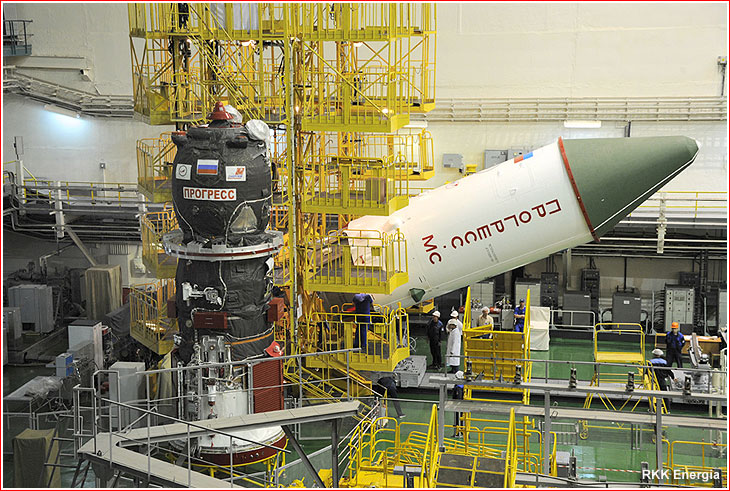
On June 9, the payload section was transported from Site 254 to the vehicle assembly building at Site 31 for integration with its Soyuz-2-1a rocket and, the next day, the final assembly of the launch vehicle was completed and the rocket was declared ready for the rollout to the launch pad. On June 11, 2017, Soyuz-2-1a with Progress MS-06 arrived at Pad No. 6 at Site 31, where it was installed in vertical position. Launch personnel then began operations of the first launch day, which included general tests and the analysis of the telemetry data, Roskosmos said.
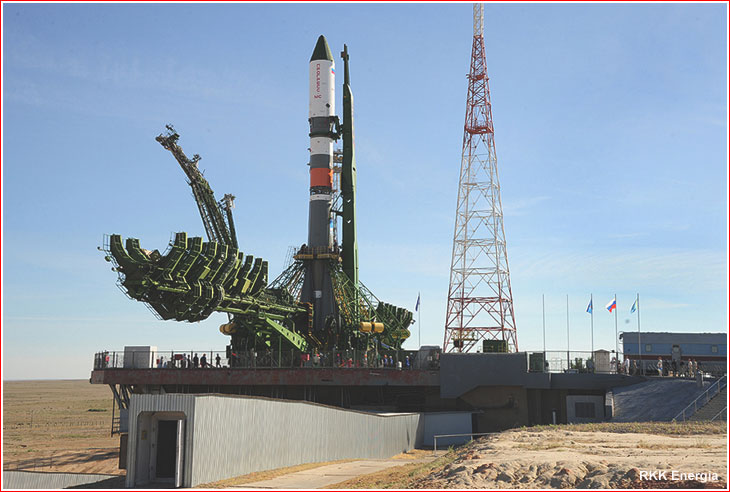
The Soyuz-2-1a rocket with the Progress MS-06 spacecraft shortly after arrival at launch pad on June 11, 2017.
The State Commission overseeing the launch was expected to convene in the early morning of June 14 to give approval for the fueling of the launch vehicle on the pad and final operations before liftoff.
Launch profile
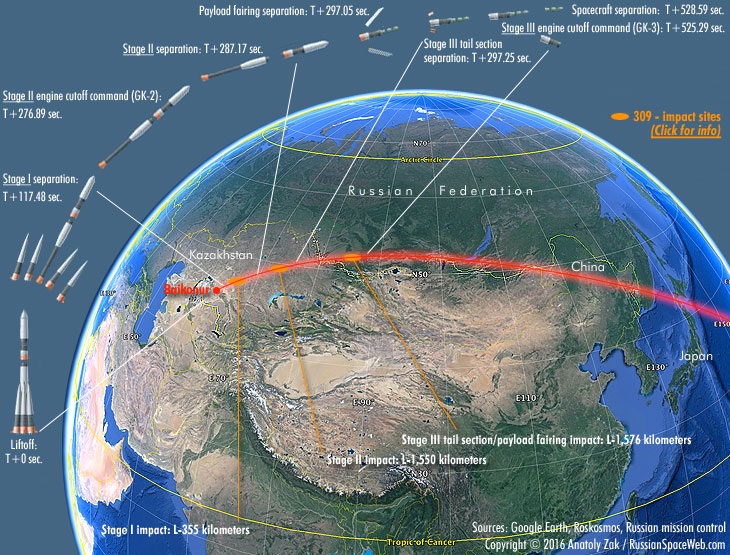
A Soyuz-2-1a rocket rocket carrying the Progress MS-06 (No. 436) cargo ship lifted off as from Pad 6 at Site 31 in Baikonur on June 14, 2017, at 12:20:13 Moscow Time (5:20 a.m. EDT).
Following a vertical liftoff, the launch vehicle headed eastward from Baikonur matching an orbital inclination of 51.66 degrees toward the Equator. The four boosters of the first stage separated nearly two minutes into the flight, while the second stage continued firing until 4.7 minutes into the flight.
The third stage ignited moments before the separation of the second stage, firing its engine through a lattice structure connecting the two boosters and ensuring the continuous thrust during the entire ascent to orbit.
Less than 10 seconds after the separation of the second stage, the payload fairing protecting the spacecraft split into two halves and fell off. A fraction of a second later, the aft cylindrical section of the third stage should split into three segments and dropped off, ensuring the fall of all the debris into the same drop zone 1,576 kilometers from the launch site.
In the meantime, the third stage kept firing until almost nine minutes into the flight. Progress MS-06 then separated from the third stage of the launch vehicle at 12:29:02 Moscow Time (5:29 a.m. EDT), just over three seconds after the third stage engine shutdown.
Impact site fire causes death, injuries
Within 24 hours after the successful launch of Progress MS-06, Kazakh authorities quoted by the official press reported that a fragment of the Soyuz rocket ignited dry grass and caused a fire 20 kilometers southwest of the village of Talap in the Karaganda Region, at the planned impact site for the first stage of the launcher. During an effort to suppress the blaze, one contractor was killed and one hospitalized with serious burns, according to the local press. Both victims were Kazakh citizens working for the Russian firm NPO Mashinostroenia, whose Base No. 1 in Kazakhstan was responsible for cleanup operations at the impact site.
The Interfax news agency quoted Roskosmos as saying that an especially strong gust of wind propelled the blaze toward the Kamaz truck, killing its driver. The second man was delivered to Dzhezkazgan's hospital in serious condition with burns over 45 percent of his body.
The headquarters of Unit 2 of the fire and emergency services in the Karaganda Region received a warning about the fire from the directorate for emergency situations in the town of Dzhezkazgan at 18:04 local time on June 14 (or more than 2.5 hours after launch at 15:20 local time), the Ekspress K news agency said.
Also, at 19:25, a Talap resident reported a fire in the grassland near the Dzhezkazgan-Kyzyl-Orda line, some 40 kilometers from Dzhezkazgan, Ekspress K said. According to the agency, the fire extended 15 kilometers but was under control by 01:20 and fully extinguished by 03:31 (local time on June 15). A total of 61 people and 22 vehicles were involved in suppressing the blaze, according to Ekspress K.
Roskosmos completes investigation into fatal impact site fire
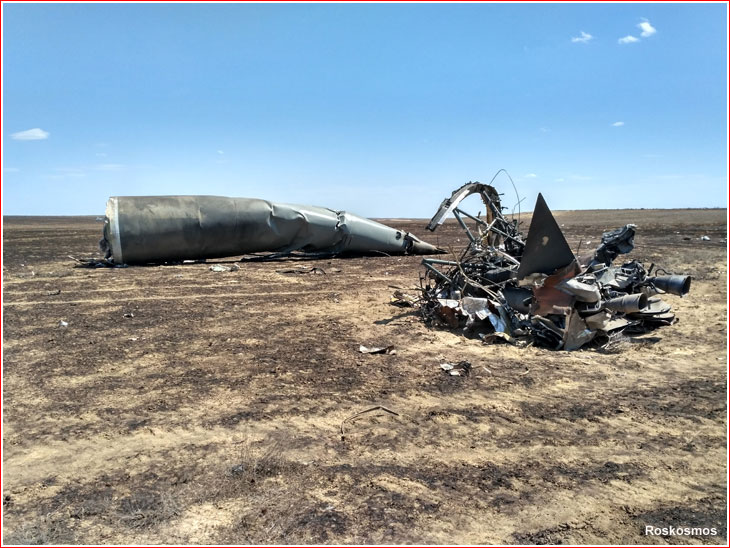
On July 7, Roskosmos State Corporation announced the end of the probe into the fire that killed two people at the impact site of a Soyuz rocket fragment, which launched the Progress MS-06 cargo ship. The investigative commission, which included experts from Roskosmos, NPO Mashinostroenia, the Kazakh emergency ministry and local officials, worked in the Karaganda Region from June 21 to June 28.
According to the corporation, the investigation confirmed that the fire had had a technical origin and had been facilitated by extremely hot temperatures reaching 35C degrees and strong winds on the day of the launch, which led to the death of Vechaslav Tyts and Yuri Khatuyshin. Roskosmos said that families of the victims had already received first insurance payments of 300 thousand rubles, with the rest of the money coming after the formal approval of the commission's work.
To prevent similar accidents in the future, Roskosmos and Kazakh authorities introduced following measures:
- Imaging of the impact sites before and immediately after each launch;
- Overflights of the impact sites after each launch;
- Activation of personnel and assets of the Kazakh emergency ministry for combating fires;
- Augmentation of ground search teams from NPO Mashinostroenia with additional fire-fighting hardware and drone personnel from the TsENKI launch operator.
Rendezvous and docking at the station
The Progress MS-06 entered its initial parking orbit with parameters close to planned specifications:
| Parameter | Planned orbit | Actual orbit |
|---|---|---|
| Orbital period | 88.54 minutes (+/-0.05 minutes) | 88.55 minutes |
| Inclination | 51.67 degrees (+/-0.03 degrees) | 51.67 degrees |
| Perigee | 193 kilometers (+/-2 kilometers) | 193.0 kilometers |
| Apogee | 240 kilometers (+/-7 kilometers) | 240.8 kilometers |
Without any additional maneuvers, the crago ship would remain in orbit for around 30 hours or 20 revolutions around the Earth.
At the time of Progress launch, the ISS was projected to be in a 404.65 by 419.38-kilometer orbit, 254.3 degrees away from the cargo ship in the so-called phasing angle.
The Progress MS-06 mission used the two-day, 34-orbit trip to the station instead of the previously available six-hour rendezvous profile.
During the long-range rendezvous process, the cargo ship conducted a dual maneuver on June 14, during the third orbit of the mission, to enter the prescribed phasing orbit with the station and a single orbit correction was performed on June 15, during the 18th revolution, before the autonomous rendezvous process began. The maneuvers were to be initiated according to the following timeline and had to result in the following orbital parameters:
| Orbit No. | Time | Firing duration | delta V | Period | Inclination | Resulting perigee | Resulting apogee |
|---|---|---|---|---|---|---|---|
| Day 1 of the mission (June 14, 2017) | |||||||
| 3 | 15:53:03 | 84.5 seconds | 33.75 m/s | 89.69 minutes | 51.67 degrees | 210.1 kilometers | 316.5 kilometers |
| 3 | 16:31:30 | 70.3 seconds | 28.28 m/s | 90.68 minutes | 51.66 degrees | 306.6 kilometers | 325.2 kilometers |
| Day 2 of the mission (June 15, 2017) | |||||||
| 18 | 13:55:09 | 11.0 seconds | 4.00 m/s | 90.82 minutes | 51.66 degrees | 317.7 kilometers | 331.9 kilometers |
The autonomous rendezvous process between the spacecraft and the station was to be initiated on June 16, 2017, at 12:19:06 Moscow Time (5:19 a.m. EDT). Final maneuvers, including flyaround of the station, station-keeping and berthing were scheduled to commence at 14:17:43 Moscow Time on (7:17 a.m. EDT).
The nominal docking was expected to be fully automated with Russian cosmonaut Fyodor Yurchikhin from the Soyuz MS-04 crew on standby at the TORU remote-control rendezvous console inside the Zvezda to take over docking operations in case of an unlikely contingency.
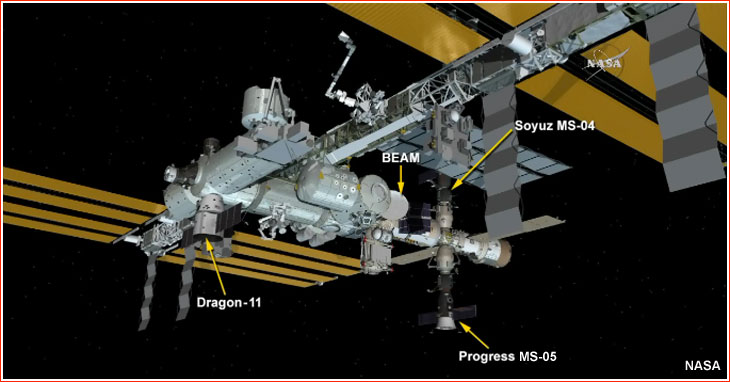
The ISS configuration prior to arrival of Progress MS-06.
According to the flight schedule, Progress MS-06 was scheduled to dock at the aft port of the Zvezda Service Module, SM, a part of the Russian segment of the ISS on June 16, 2017, at 14:42:30 Moscow Time (7:42 a.m. EDT), during 34th orbit of the cargo mission. The actual docking was confirmed a few minutes earlier, at 14:37 Moscow Time (7:37 a.m. EDT), as the two vehicles were flying north of Fillippines.
Onboard cargo
Progress MS-06 carries around 2.5 tons of food, fuel and supplies for the Expedition 52 aboard the ISS. The ship's cargo also includes several nano-satellites: Tanyusha-YuZGU-1 and -2 (a.k.a. Radioskafandr RS-6 and RS-7) with a mass of 2.5 kilograms, which was developed jointly by RKK Energia and students at the South-Western State University, YuZGU, in the city of Kursk. According to RKK Energia, the satellites will be launched by spacewalking cosmonauts to mark the 160th anniversary of Konstantin Tsiolkovsky. The satellites will then transmit congratulatory messages in Russian, English, Chinese and Spanish using ham radio frequencies, RKK Energia said.
In addition, Progress MS-06 carried the Sfera-53 radar calibration satellite and the 7.3-kilogram TNS-O No. 2 satellite developed at Moscow-based AO RKS corporation.
Cargo aboard Progress MS-06:
| Propellant in the refueling tanks | 620 kilograms |
|---|---|
| Oxygen in the Oxygen Supply System, SrPK | 47 kilograms |
| Water in the Rodnik system | 420 kilograms |
| Total mass of supplies in the pressurized cargo compartment, including... | 1,311 kilograms |
| Gas Content System, SOGs | 27 kilograms |
| Water Supply System, SVO | 369 kilograms |
| Thermal Control System, SOTR | 43 kilograms |
| Power Supply System, SEP | 77 kilograms |
| Servicing and Repair System, STOR | 5 kilograms |
| Telephone and Telegraph Communications System, STGS | 2 kilograms |
| Medical Supplies, SMO | 144 kilograms |
| Personal Protection Equipment, SIZ | 119 kilograms |
| Sanitary and Hygiene Supplies, SGO | 90.6 kilograms |
| Sputnik HAM radio | 0.6 kilograms |
| Food Provisions, SOP, (containers with food, fresh food items) | 351 kilograms |
| Onboard documentation, personal packages for the crew, video and photo equipment | 30 kilograms |
| Expendable materials and scientific equipment for ISS experiments | 69 kilograms |
| Means of repair and sevicing | 36 kilograms |
| Equipment for the FGB module | 6 kilograms |
| Equipment for MIM1 module | 19 kilograms |
| Equipment for MIM2 module | 14 kilograms |
| NASA cargo for Russian members of the crew | 71 kilograms |
| Total mass of cargo | 2,398 kilograms |
Progress MS-06 completes its mission
As originally planned, Progress MS-06 remained docked at the ISS until the end of December 2017. Like most its predecessors, the spacecraft was filled with trash at the end of its mission. According to Roskosmos, Progress MS-06 undocked from the aft section of the Zvezda Service Module on Dec. 28, 2017, at 04:03:30 Moscow Time (8:03 p.m. EST on December 27). On the same day, at 07:10 Moscow Time (11:10 p.m. EST on December 27), the ship's main engine was fired for three minutes, pushing the vehicle toward reentry into the Earth's atmosphere, which took place at 07:43 Moscow Time (11:43 p.m. EST on December 27).
According to calculations of mission control, surviving debris of the vehicle hit the waters in the remote region of the Pacific Ocean at 07:51:34 Moscow Time on December 28, 2017, (11:51 p.m. EST on December 27), Roskosmos said.
Next mission: Progress MS-07
Read much more about the history of the Russian space program in a richly illustrated, large-format glossy edition:
This page is maintained by Anatoly Zak; Last update:December 28, 2017
Page editor: Alain Chabot; Last edit: June 12, 2017
All rights reserved
)
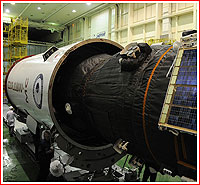



)
)
)
)
)
)
)
)